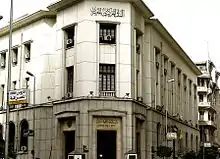 | |
| Headquarters | Cairo |
|---|---|
| Coordinates | 30°03′16.9″N 31°14′48.0″E / 30.054694°N 31.246667°E 30°03′29″N 31°14′03″E / 30.0581°N 31.2343°E |
| Established | 25 June 1898[1] |
| Ownership | 100% state ownership[2] |
| Governor | Hassan Abdullah |
| Central bank of | Egypt |
| Currency | Egyptian pound EGP (ISO 4217) |
| Reserves | US$33.375 billion[2] |
| Bank rate | 12.25[3] |
| Interest on reserves | 11.25%[3] |
| Preceded by | National Bank of Egypt (until 1960) |
| Website | www.cbe.org.eg |
The Central Bank of Egypt (CBE; Arabic: البنك المركزي المصري) is the central bank and monetary authority of the Arab Republic of Egypt.
Currency
Since the trading of gold and silver coins in Egypt and until 1834, there was no one unit of currency to unify the country. In 1834, a decree was realised stating the forging of an Egyptian currency based on the two metals (gold and silver). In accordance with said decree, the minting of a currency in the shape of gold and silver Riyals began. In 1836, the Egyptian pound was first introduced and it became open for public use.[4]
The bank floated the Egyptian pound during the morning of the 13th of November 2016.[5] [6]
Functions
Its functions include
- Regulates banks and the banking system of Egypt;
- Formulates and implements Egypt's banking policy, monetary policy and credit policy;
- Issues banknotes;
- Manages gold and the foreign exchange reserves of the Arab Republic of Egypt
- Regulates and manages Egypt's presence in the foreign exchange market;
- Supervises the national payments system;
- Manages Egypt's public and private external debt.
List of governors

Central Bank building in Cairo
Following is a list of the Governors of the Central Bank of Egypt:[7]
| Name | Took office | Left office |
|---|---|---|
| Sir Elwin Palmer | August 1898 | January 1906 |
| Sir Frederick Rowlatt | June 1906 | February 1921 |
| Sir Bertram Hornsby | March 1921 | February 1931 |
| Sir Edward Cook | March 1931 | October 1940 |
| Sir Norman Nixon | October 1940 | April 1946 |
| Sir Frederick Leith-Ross | May 1946 | April 1951 |
| Ahmed Zaki Saad | May 1951 | April 1952 |
| Mohamed Fekry | May 1952 | March 1955 |
| Ahmed Zaki Saad | March 1956 | July 1957 |
| Abd El-Gelil El Emary | November 1957 | March 1960 |
| Abd El-Hakim El Refaie | March 1960 | March 1964 |
| Ahmed Zendo | March 1964 | February 1967 |
| Ahmed Nazmy | February 1967 | January 1971 |
| Ahmed Zendo | February 1971 | March 1976 |
| Mohamed Abd El Fatah Ibrahim | March 1976 | January 1982 |
| Mohamed Shalaby | February 1982 | March 1985 |
| Ali Negm | March 1985 | November 1986 |
| Mahmoud Hamed | November 1986 | October 1993 |
| Ismail Hassan Mohamed | October 1993 | October 2001 |
| Mohamed Abul Eyoun | October 2001 | November 2003 |
| Farouk El-Okdah | December 2003 | February 2013 |
| Hisham Ramez | February 2013 | November 2015 |
| Tarek Hassan Amer | November 2015 | August 2022 |
| Hassan Abdalla | August 2022 | Present |
See also
References
- ↑ http://www.bcl.lu/fr/publications/autres_publications/brochure_2008.pdf
- 1 2 Weidner, Jan (2017). "The Organisation and Structure of Central Banks" (PDF). Katalog der Deutschen Nationalbibliothek.
- 1 2 "Press Release". Central Bank of Egypt. 2019-03-28. Retrieved 2019-03-31.
- ↑ "نبذة تاريخية" (in Arabic). Central Bank of Egypt. Retrieved 28 June 2019.
- ↑ Hossam Mounir (November 2, 2017) — Flotation was boldest decision in history of Egyptian economic, banking sectors, published by Daily News Egypt - accessed 2020-02-14
- ↑ The EGP Devaluation: A new beginning, published by PwC - accessed 2020-02-14
- ↑ "CBE Governors". www.cbe.org.eg. Archived from the original on 2018-12-30. Retrieved 2019-03-31.
External links
This article is issued from Wikipedia. The text is licensed under Creative Commons - Attribution - Sharealike. Additional terms may apply for the media files.